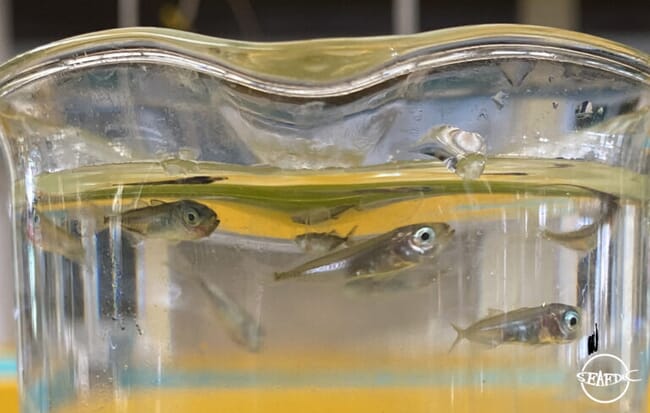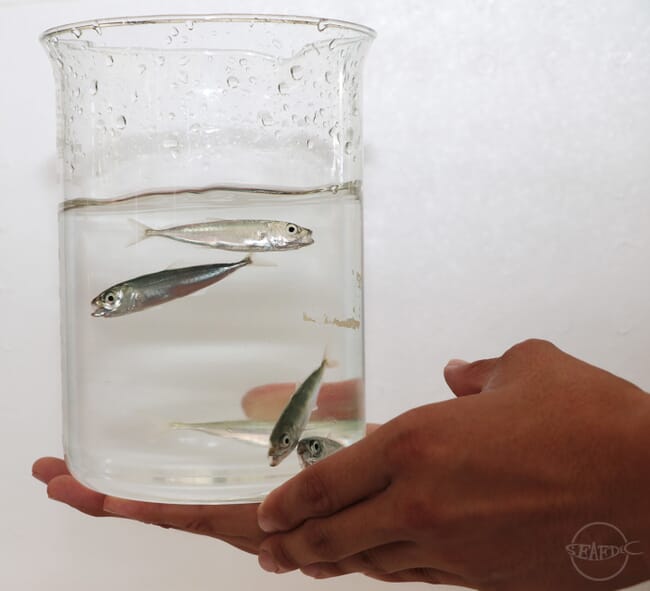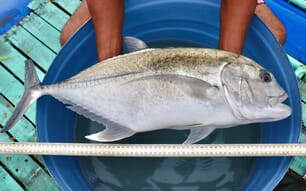
© JF Aldon
In a world’s first, researchers successfully spawned the round scad (Decapterus macrosoma) in captivity at SEAFDEC/AQD in Tigbauan, Iloilo, marking a critical milestone towards farming the fish, locally known as galunggong.
Round scad is considered a staple fish in the Philippines with over 202,000 metric tonnes harvested by commercial and municipal fisheries in 2020, according to government statistics. However, the haul could not keep up with market demand leading to increasing prices, now reaching $5 to $6 per kg, and controversial moves to import the fish amid closed fishing seasons.
“Our breeders have been spawning continuously since December last year until this February, and we now have thousands of galunggong in different larval to early juvenile stages at our hatchery which we hope to further grow to market sizes to prove that we can farm galunggong,” said SEAFDEC/AQD chief Dan Baliao in an interview last on 28 February 2022.

© JF Aldon
Researcher Ma. Irene Cabanilla-Legaspi said they started collecting wild broodstocks off Southern Iloilo and Antique in 2020 as part of a Government of Japan-funded project at SEAFDEC/AQD, the same research centre responsible for ground-breaking studies on breeding milkfish in the 1970s and 1980s.
After collecting round scad broodstocks onboard commercial fishing vessels and through fish traps, Cabanilla-Legaspi’s team transported them to SEAFDEC/AQD’s headquarters in Tigbauan and stocked them in fish tanks to prepare them for spawning.
Broodstock caught in August and October 2021 began laying eggs that December and continued to produce good eggs through February 2022. Though this is still in an early experimental stage, the hatchery boasts fingerlings that are more than 50 days old.
“Very fast” growth
“We observed that the fish were growing very fast. When they reach 20 days old, they have a very fast growth and we can obtain 2.5-centimeter round scad in 25 days,” Cabanilla-Legaspi said.
Although trials in the hatchery are limited, SEAFDEC/AQD scientist Dr Leobert de la Peña noted that the round scad fry also have “very high survival” compared to other marine fish being grown at SEAFDEC/AQD, reaching as much as 20 percent survival 25 days after they hatch.
Meanwhile, the SEAFDEC/AQD team will continue to collect broodstock from the wild for more experimental runs that will also cover studying the fish’s larval development, reproductive development, feeding habits and the formulation of hatchery, nursery and grow-out procedures.
“We hope our attempts to grow galunggong will proceed quickly. We are excited to roll out the technology and promote the culture of galunggong so prices may become more affordable as farms can surely augment the catch from the wild,” Baliao added.
SEAFDEC/AQD deputy chief Dr Sayaka Ito also noted that round scad is a potential export product for the Philippines as it is now being imported by Japan as otsumami, a kind of snack or finger food.
The research on round scad is under an umbrella program at SEAFDEC/AQD that aims to develop aquaculture technologies on new aquatic species that also includes kawakawa (mackerel tuna) and flathead lobster. The main goal of the research programme is to close the life cycle of these species in captivity and to develop production techniques for hatchery, nursery, and grow-out.




